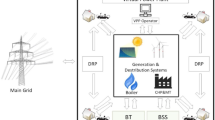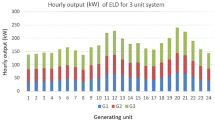Abstract
Multi-energy virtual power plant (MEVPP) has attracted more and more attention due to its advantages in renewable energy consumption and carbon emission reduction. However, the characteristics of multi-energy coupling and the access of renewable energy may lead to some challenges in the operation of MEVPP. In this paper, a data-driven distributionally robust chance constraints optimization model (DD-DRCCO) is proposed for the dispatching of MEVPP. Firstly, the uncertainties of wind power and photovoltaic output forecasting errors are modeled as an ambiguity set based on the Wasserstein metric. Secondly, combined with the chance constraint, the expected probability of the inequality constraint with uncertain variables is limited to the lowest allowable confidence level to improve the reliability of the model. Thirdly, the forecast errors of wind power and photovoltaic are considered in the constraint conditions, so that the system can effectively resist the interference of uncertain output. Besides, based on the strong duality theory, the DD-DRCCO model is equivalent to a MILP problem which is easy to solve. Finally, simulations implemented on a typical MEVPP are delivered to show that our proposed model: 1) The model is data-driven, and the conservativeness is kept at a low level, and the solution time is about 7s~8s; 2) The MEVPP system can achieve a balance between economy and low-carbon, making the total operation cost reduced by 0.89% compared with no increase of electric boiler; 3) The CO2 emission during the operation of the MEVPP system was significantly reduced by about 87.33 kg.










Similar content being viewed by others
Data availability
The datasets used and/or analyzed during the current study are available from the corresponding author on reasonable request.
References
Afzal A, Alshahrani S, Alrobaian A et al (2021) Power plant energy predictions based on thermal factors using ridge and support vector regressor algorithms. Energies 14(21):7254
Chen S, Li Z, Li W (2021) Integrating high share of renewable energy into power system using customer-sited energy storage. Renew Sust Energ Rev 143:110893
Dalala Z, Al-Omari M, Al-Addous M et al (2022) Increased renewable energy penetration in national electrical grids constraints and solutions. Energy 246:123361
Gao Y, Lu Y, Su CW et al (2023) Does China’s low-carbon action reduce pollution emissions? A quasi-natural experiment based on the low-carbon city construction. Environ Sci Pollut Res 30(10):27013–27029
Ikäheimo J, Weiss R, Kiviluoma J et al (2022) Impact of power-to-gas on the cost and design of the future low-carbon urban energy system. Appl Energy 305:117713
Jin J, Wen Q, Qiu Y et al (2023) Distributed robust optimization for low-carbon dispatch of wind-thermal power under uncertainties. Environ Sci Pollut Res 30(8):20980–20994
Jordehi AR (2022) A stochastic model for participation of virtual power plants in futures markets, pool markets and contracts with withdrawal penalty. J Energy Storage 50:104334
Ju L, Zhao R, Tan Q et al (2019) A multi-objective robust scheduling model and solution algorithm for a novel virtual power plant connected with power-to-gas and gas storage tank considering uncertainty and demand response. Appl Energy 250:1336–1355
Klemm C, Vennemann P (2021) Modeling and optimization of multi-energy systems in mixed-use districts: a review of existing methods and approaches. Renew Sust Energ Rev 135:110206
Kong X, Xiao J, Liu D et al (2020) Robust stochastic optimal dispatching method of multi-energy virtual power plant considering multiple uncertainties. Appl Energy 279:115707
Kong X et al (2019) Bi-level multi-time scale scheduling method based on bidding for multi-operator virtual power plant. Appl Energy 249:178–189
Lin F, Fang X, Gao Z (2022) Distributionally robust optimization: A review on theory and applications. Numerical Algebra, Control Optim 12(1):159–212
Liu X (2022) Research on bidding strategy of virtual power plant considering carbon-electricity integrated market mechanism. Int J Electr Power Energy Syst 137:107891
Naval N, Sánchez R, Yusta JM (2020) A virtual power plant optimal dispatch model with large and small-scale distributed renewable generation. Renew Energy 151:57–69
Naval N, Yusta JM (2021) Virtual power plant models and electricity markets—a review. Renew Sust Energ Rev 149:111393
Qiu R, Sun Y, Sun M (2021) A distributionally robust optimization approach for multi-product inventory decisions with budget constraint and demand and yield uncertainties. Comput Oper Res 126:105081
Rahimi M, Ardakani FJ, Olatujoye O et al (2022) Two-stage interval scheduling of virtual power plant in day-ahead and real-time markets considering compressed air energy storage wind turbine. J Energy Storage 45:103599
Rashdi S, Sudhir CV, Basha J et al (2022) A case study on the electrical energy auditing and saving techniques in an educational institution (IMCO, Sohar, Oman). Case Stud Therm Eng 31:101820
Shi R, Li S, Zhang P et al (2020) Integration of renewable energy sources and electric vehicles in V2G network with adjustable robust optimization. Renew Energy 153:1067–1080
Shi Z, Liang H, Dinavahi V (2019) Data-driven distributionally robust chance-constrained unit commitment with uncertain wind power. IEEE Access 7:135087–135098 (24)
Shinde P, Kouveliotis-Lysikatos I, Amelin M (2022) Multistage stochastic programming for vpp trading in continuous intraday electricity markets. IEEE Trans Sustain Energy 13(2):1037–1048
Sun Y, Qiu R, Sun M (2022) Optimizing decisions for a dual-channel retailer with service level requirements and demand uncertainties: a Wasserstein metric-based distributionally robust optimization approach. Comput Oper Res 138:105589
Tang W, Yang HT (2019) Optimal operation and bidding strategy of a virtual power plant integrated with energy storage systems and elasticity demand response. IEEE Access 7:79798–79809
Wang H, Riaz S, Mancarella P (2020a) Integrated techno-economic modeling, flexibility analysis, and business case assessment of an urban virtual power plant with multi-market co-optimization. Appl Energy 259:114142
Wang X, Li B, Wang Y et al (2022a) A bargaining game-based profit allocation method for the wind-hydrogen-storage combined system. Appl Energy 310:118472
Wang X, Zhao H, Su Q et al (2022b) Value quantification of multiple energy storage to low-carbon combined heat and power system. Environ Sci Pollut Res 29(48):73577–77359
Wang Y, Yang Y, Tang L et al (2020b) A Wasserstein based two-stage distributionally robust optimization model for optimal operation of CCHP micro-grid under uncertainties[J]. Int J Electr Power Energy Syst 119:105941 (34)
Wu H, Liu X, Ye B et al (2019a) Optimal dispatch and bidding strategy of a virtual power plant based on a Stackelberg game. IET Generation, Transmission & Distribution 14(4):552–563
Wu X, Qi S, Wang Z et al (2019b) Optimal scheduling for microgrids with hydrogen fueling stations considering uncertainty using data-driven approach. Appl Energy 253:113568
Xia Y, Duan D, Liu Y et al (2019) Optimal schedule model for a virtual power plant with an energy storage system. Proc Inst Civil Eng Energy 172(4):169–178
Xiao C, Sutanto D, Muttaqi KM et al (2020) Multi-period data driven control strategy for real-time management of energy storages in virtual power plants integrated with power grid. Int J Electr Power Energy Syst 118:105747
Yin S, Ai Q, Li Z et al (2020) Energy management for aggregate prosumers in a virtual power plant: A robust Stackelberg game approach. Int J Electr Power Energy Syst 117:105605
Zhang H, Xu T, Wu H et al (2019) Risk-based stochastic day-ahead operation for data centre virtual power plants. IET Renew Power Gen 13(10):1660–1669
Zhang Y, Yuan F, Zhai H et al (2023a) Optimizing the planning of distributed generation resources and storages in the virtual power plant, considering load uncertainty. J Clean Prod 387:135868
Zhang Y, Qi E, Wang H (2023b) Study on the necessity and strategy of popularization of “near-zero emission” technology for thermal power generation. Environ Sci Pollut Res 30(4):10297–10311
Zhao P, Gu C, Huo D et al (2019) Two-Stage Distributionally Robust Optimization for Energy Hub Systems. IEEE Trans Indust Inform 16(5):3460–3469
Zhou Y, Wei Z, Sun G et al (2019) Four-level robust model for a virtual power plant in energy and reserve markets. IET Gener Transm Distrib 13(11):2036–2043
Funding
This study is supported by the National Natural Science Foundation of Hebei Province (G2020502004) and Beijing Social Science Foundation Project (22JCC115).
Author information
Authors and Affiliations
Contributions
Huiru Zhao and Yuwei Wang guided the research, established the model, and implemented the simulation; Xuejie Wang wrote this article; Bingkang Li and Zhuoya Siqin checked the language.
Corresponding author
Ethics declarations
Ethics approval and consent to participate
Not applicable.
Consent for publication
Not applicable.
Competing interests
The authors declare no competing interests.
Additional information
Responsible Editor: Roula Inglesi-Lotz
Publisher’s note
Springer Nature remains neutral with regard to jurisdictional claims in published maps and institutional affiliations.
Appendices
Appendix 1. Conditional value at risk approximation
The chance constraints in the model are nonlinear and difficult to solve directly. By introducing the relevant parameter vector α(x) and β(x), the chance constraints are simplified as follows:
In this paper, the conditional risk value approximation of the above probability constraint formula is carried out by introducing auxiliary variables t1, t2, sj, so as to convert it into a solvable linear constraint.
However, when the scale of the historical sample data is large, the number of auxiliary variables in the above formula will also increase, resulting in increased computational difficulty. Therefore, the above formula is further relaxed.
Appendix 2. Relevant parameters
Appendix 3. Hourly forecasted power data
Rights and permissions
Springer Nature or its licensor (e.g. a society or other partner) holds exclusive rights to this article under a publishing agreement with the author(s) or other rightsholder(s); author self-archiving of the accepted manuscript version of this article is solely governed by the terms of such publishing agreement and applicable law.
About this article
Cite this article
Zhao, H., Wang, X., Siqin, Z. et al. Two-stage optimal dispatching of multi-energy virtual power plants based on chance constraints and data-driven distributionally robust optimization considering carbon trading. Environ Sci Pollut Res 30, 79916–79936 (2023). https://doi.org/10.1007/s11356-023-27955-6
Received:
Accepted:
Published:
Issue Date:
DOI: https://doi.org/10.1007/s11356-023-27955-6




